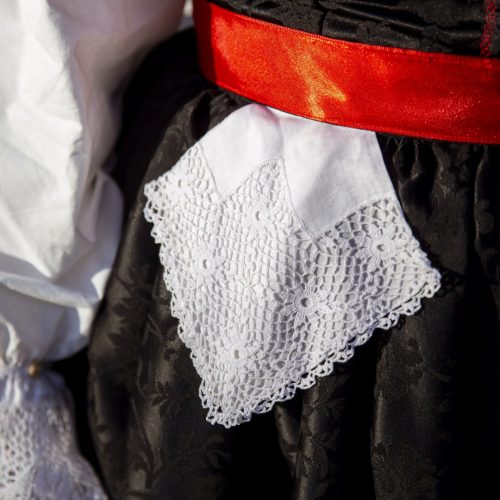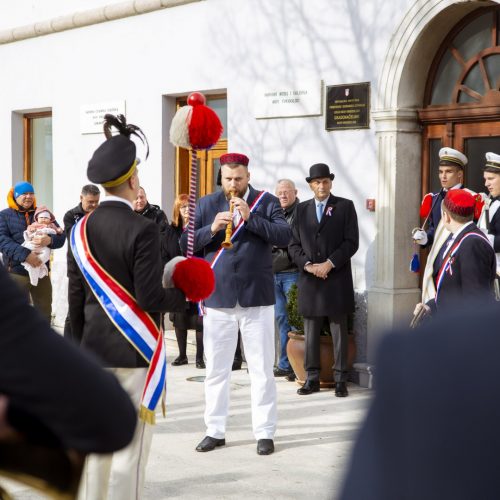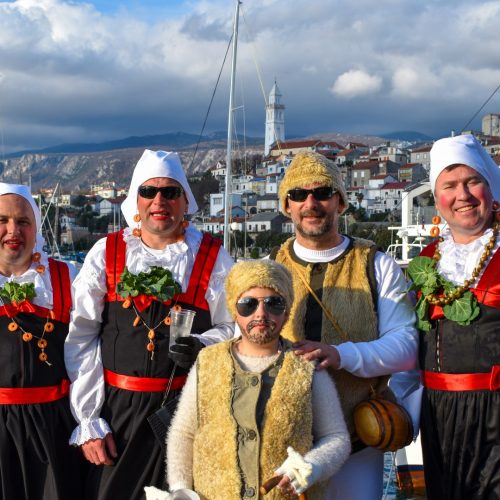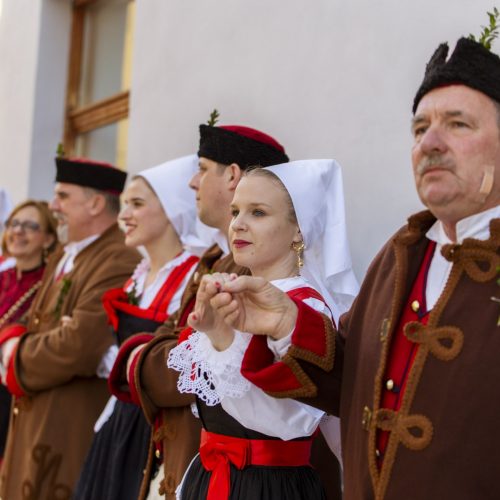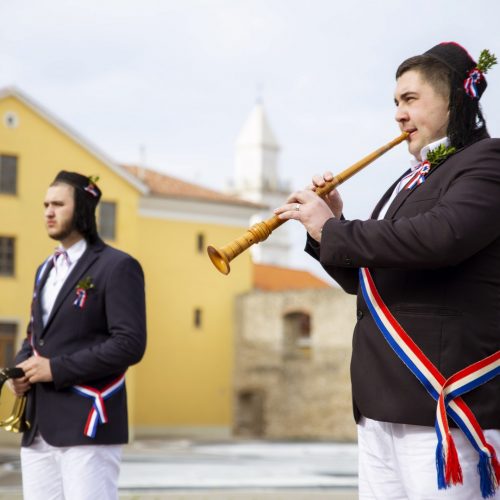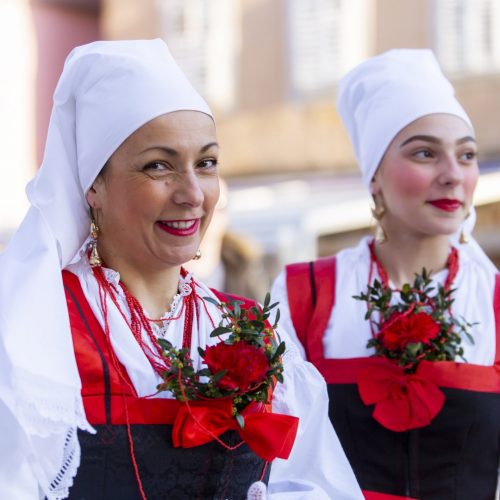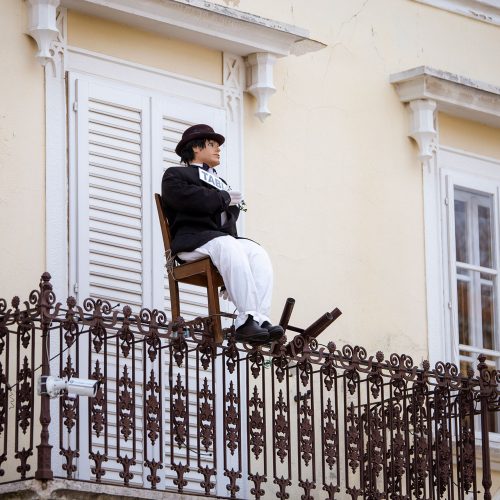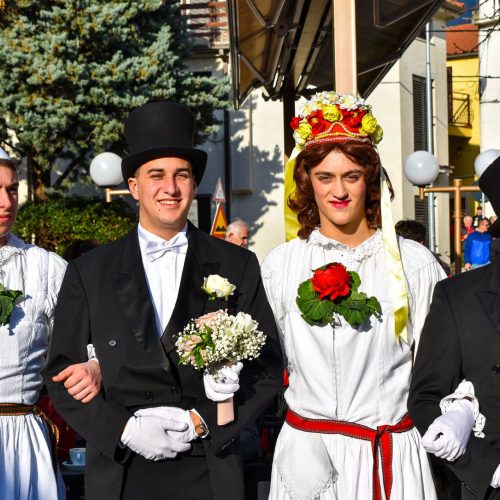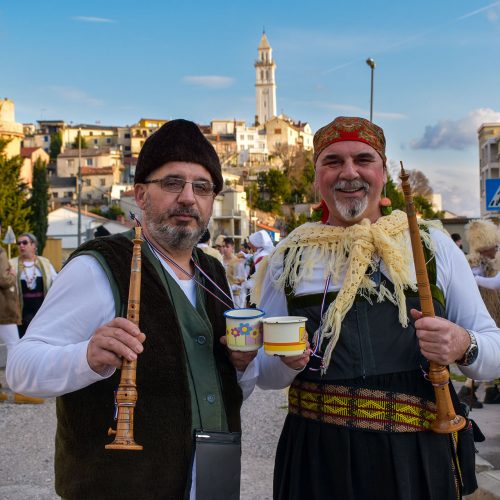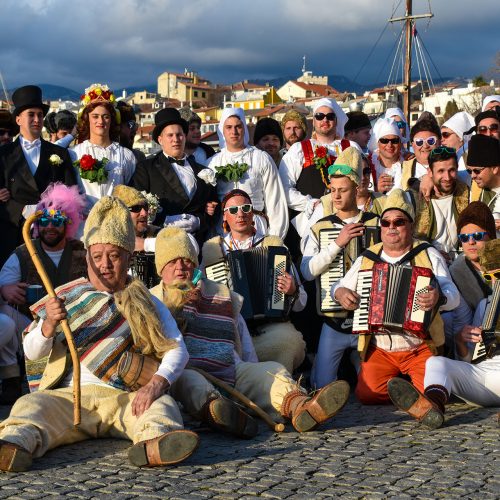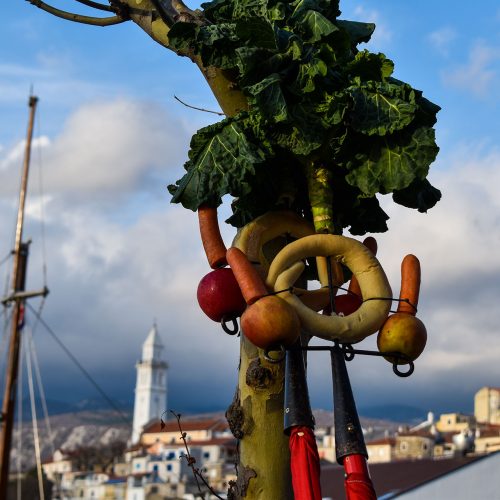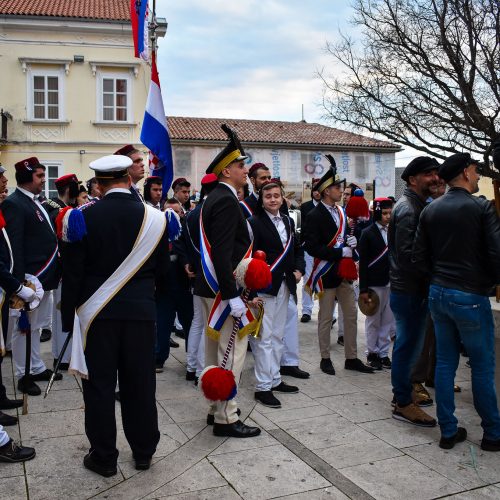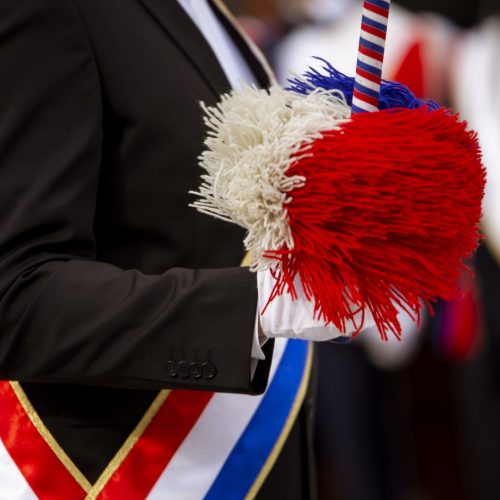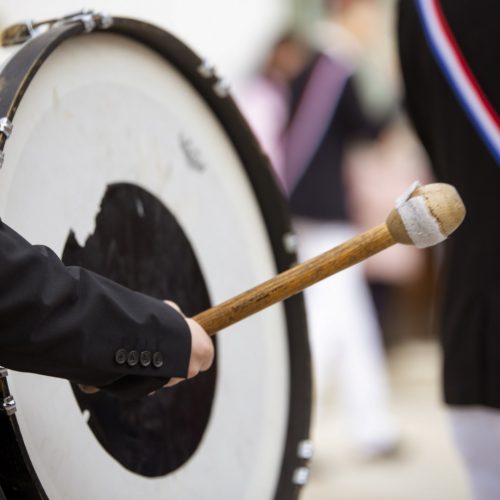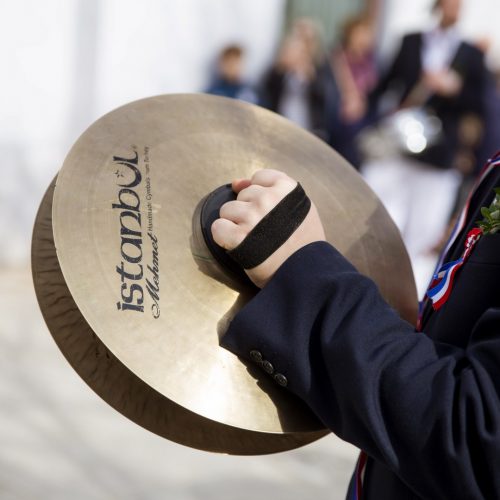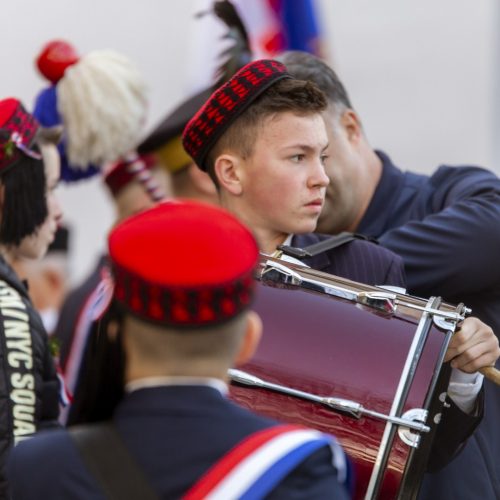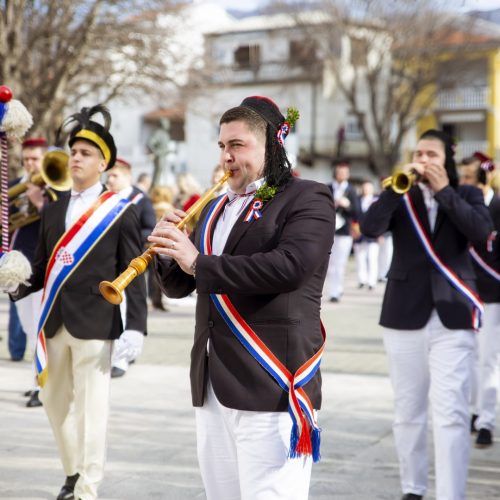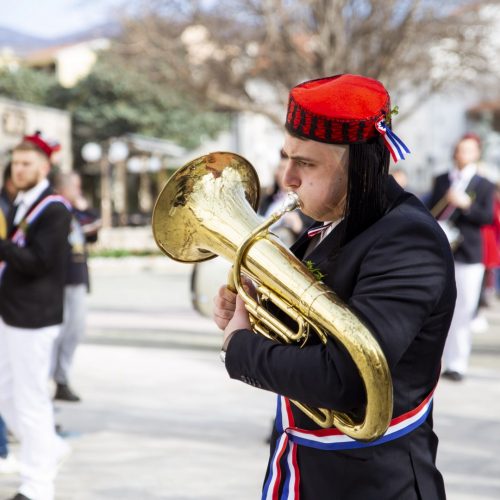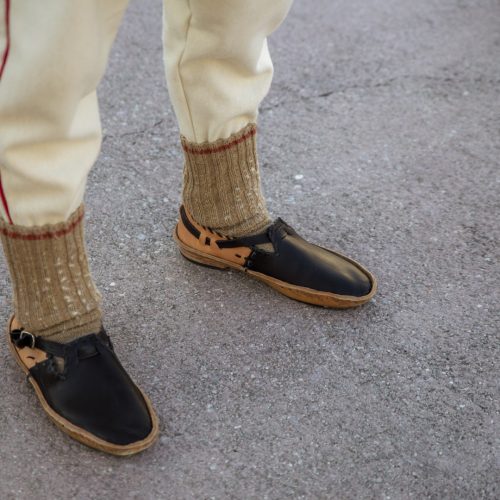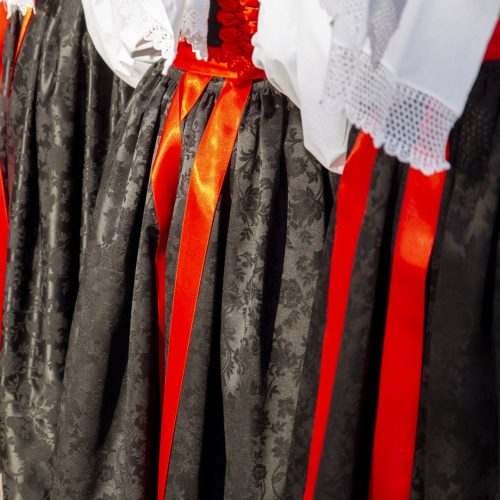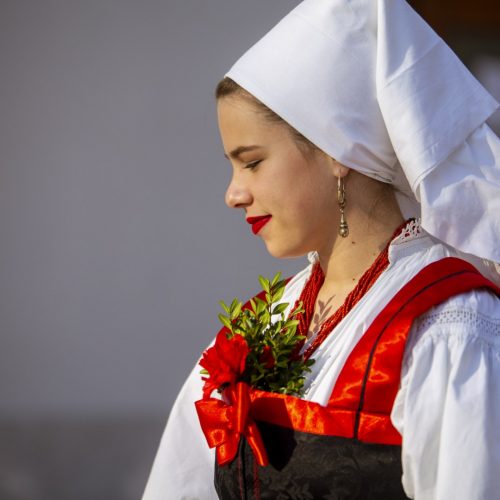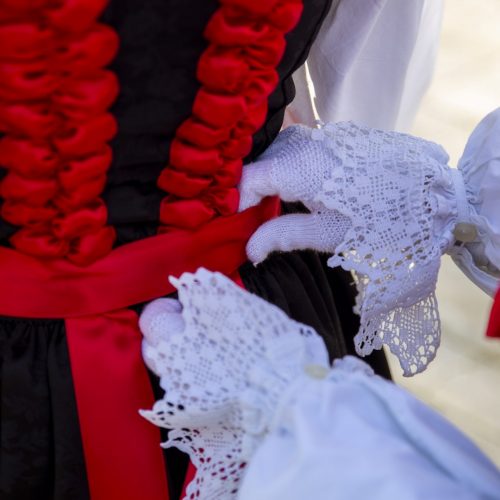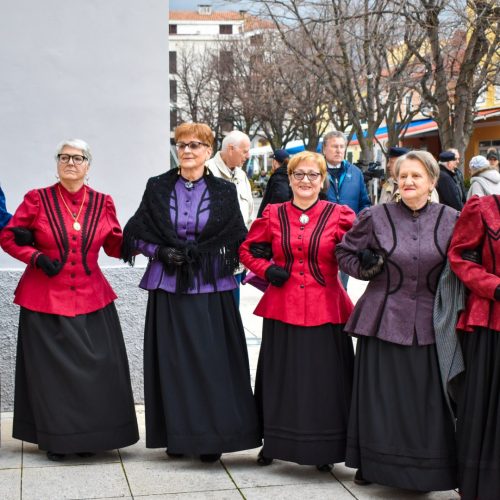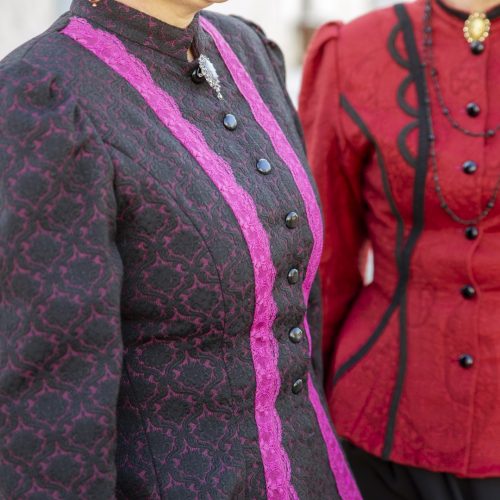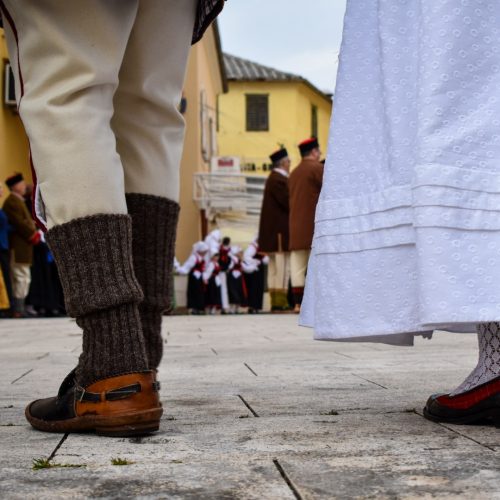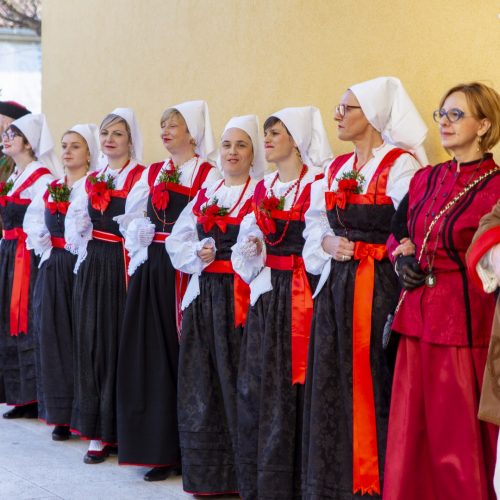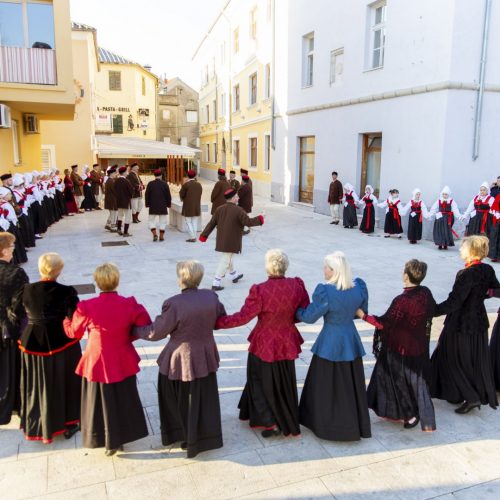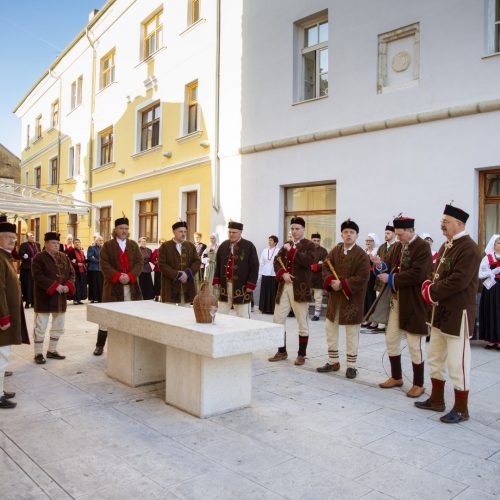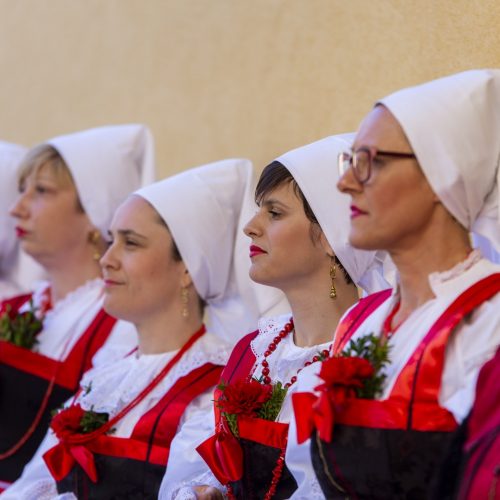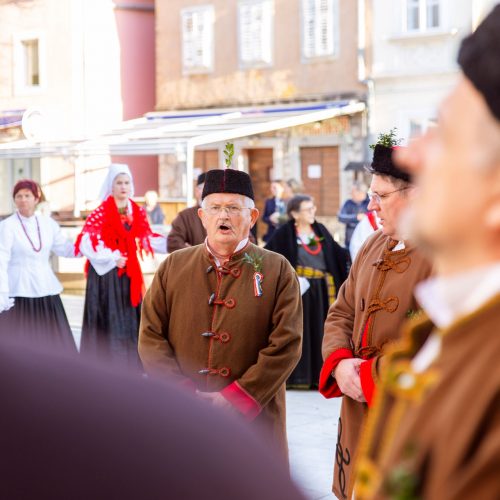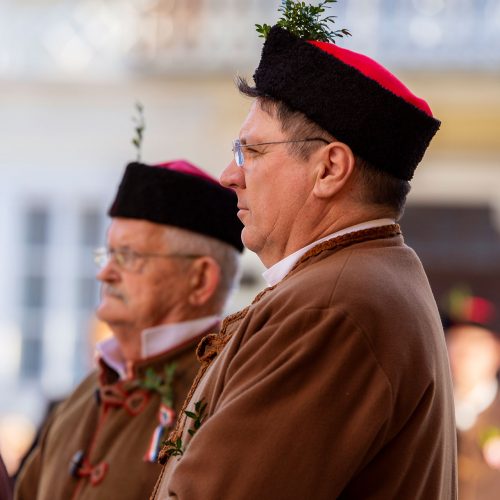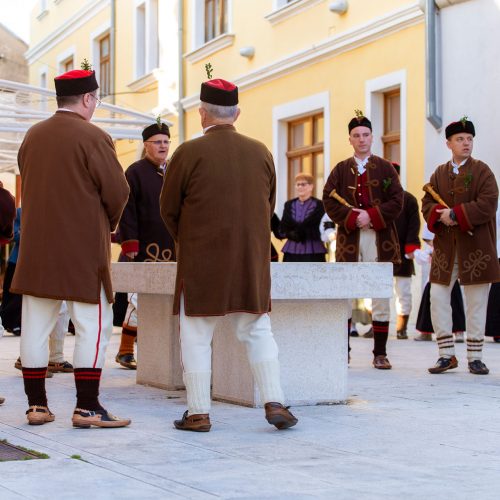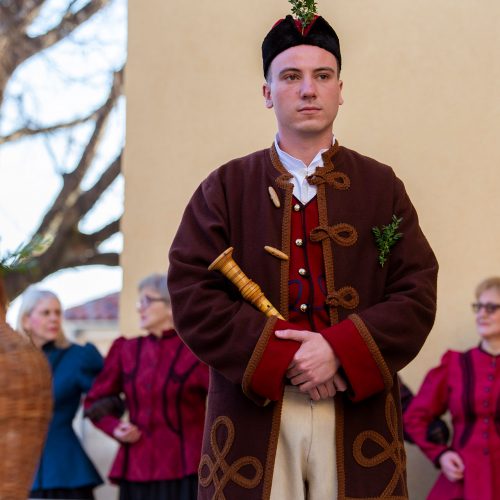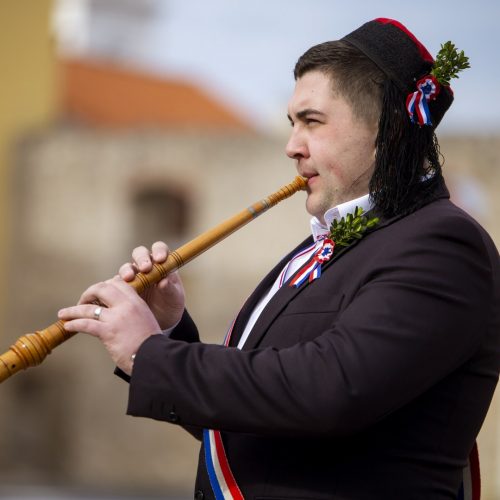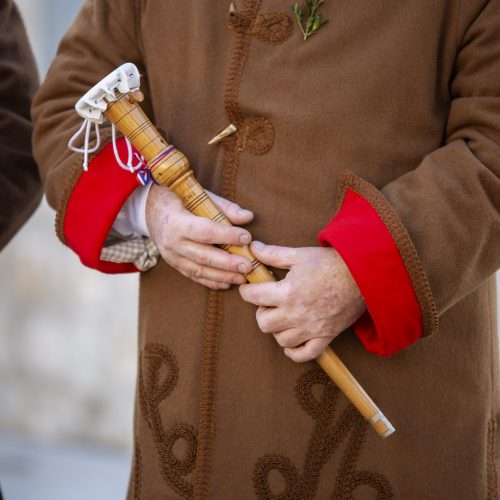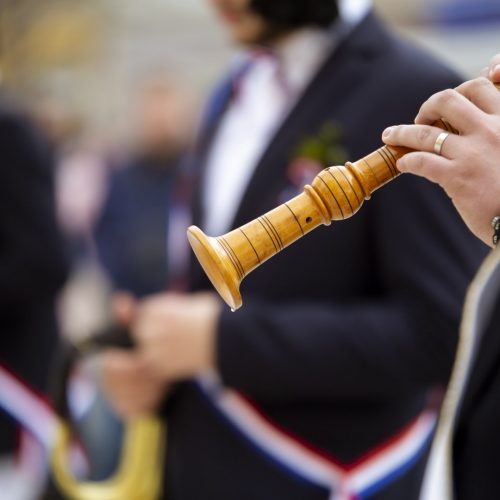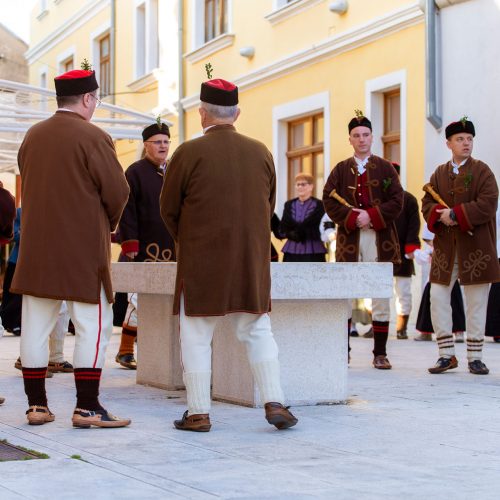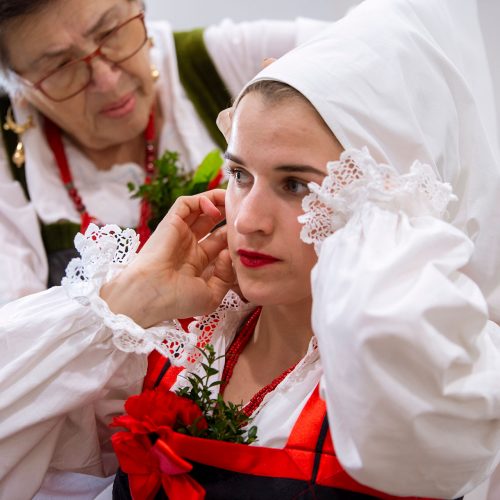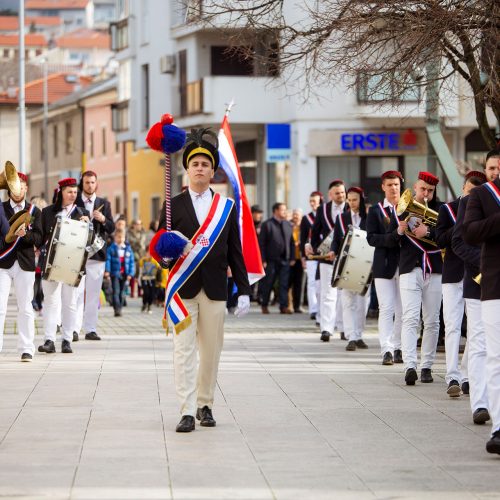Novljanski mesopust
Novljanski mesopust – carnival custom from the area of Novi Vinodolski was declared an intangible cultural heritage of the Republic of Croatia in 2011.
Mesopust is one of annual customs of the winter cycle. Its continuity can be traced to the mid-19th century to the present day. This is made possible by the collection of Novi’s žitak, parody chronicles of local events written in octosyllable. The first preserved and later published žitak is the one from 1862. There is also a well-known žitak from 1718 found in Dobrinj, on the island of Krk, entitled Mesopustova oporuka (Mesopust’s will).
The backbone of Novi’s mesopust is the evocation of the wedding in the carnival period, which includes the representative forms of events Napovidanja dovcen and dovican and Ženidba mlade Mesopustove, as well as the trial and execution of the carnival culprit Mesopust whose life course is traced from mišenje i kršćenje (baptism) to the trial (reading of žitak and Mesopust’s will) to the Sprogoda Mesopusta and its incineration.
Many traces testify to the antiquity of the custom: in the days of Mesopust, folk songs are sung with a recognised theme of sacred songs of pre-Christian antiquity. Ženidba mlade Mesopustove (The wedding of the bride of Mesopust) coincides with pre-Christian traditions – the Slavic holy wedding of Jaril and Morana, which restores the vegetation cycle. Sprogod Mesopusta coincides with the incineration of Jaril or Morana as straw puppets at the end of winter.
The practices of the customs are carried out by the participants in a strictly established traditional form and they last three weeks, twenty-one days, from the First Thursday to Maundy Wednesday / Ash Wednesday, with nine days of events in that period.
Mesopust is the most esteemed folk custom of Novi Vinodolski, in which many residents take part. According to personal preferences they participate in carnivals, as singers and participants in the kolo dance, as participants in the carnival trial for Mesopust or just as curious observers.
For those who want to know more about the custom, book Polak obicaja i navade stare is available at the bottom of the page, along with the songs from dance kolo from Novi and other folk songs.
The course of events
FIRST THURSDAY TUSTI: Prvo napovidanje dovcen i dovican is taking place – mesopustari come out in civilian clothes as masopust musicians and around 22:00 they announce widows and widowers at the intersections of the city centre.
THE BRIDE OF MESOPUST: The Sunday after the first Thursday, in the morning, Stari svati (as the fathers of the newlyweds) announce the marriage and invite everyone to the wedding. In the afternoon, a wedding is held, staged by mesopustari dressed in women’s and men’s antique clothing. All participants are men.
SECOND THURSDAY KUSI: The second announcement takes place after 22:00.
THIRD THURSDAY POBERUHI: In the afternoon, Zeča takes place – traditional masquerade invites widows and widowers on a honeymoon boat trip on Zeča (isolated rocky island Zec in the Velebit Channel). In the evening at 20:00 mesopustari walk around the old town three times, and at midnight they give announcements (napovidanje).
MESOPUST SATURDAY – MIŠENJE I KRŠĆENJE MESOPUSTA (Baptism of Mesopust): A human-sized puppet is made of straw (mesopust), dressed in white trousers, a white shirt and black jacket, covered with a half-cylinder and seated on a chair. At midnight, during the process of baptism, he will get the annual (current) name, which mocks, condemns or ironizes a local event or occurrence. The name that gets the biggest support among offered names is attached to the mesopust’s chest, and mesopustari then carry it around the city three times with music (the centre of the medieval settlement) and hang it on Travica – the southern facade of Kaštel.
MESOPUST SUNDAY: Between 10:00 and 11:00, mesopustari go out for the first time in their ceremonial uniforms on the square in front of the Frankopan castle. They greet the town, town administration and Mesopust hanging on Travica – a place on the castle. They then tour the city and greet all citizens, from house to house. In the afternoon (around 15:00), citizens dressed in festive folk costumes gather on the Square. Accompanied by the instrument sopile, the participants go to the square where the dance kolo from Novi is danced. Singers singing heroic folk songs invite people to kolo that participants form around them. In the evening, mesopustari break the kolo. They take Mesopust off Travica, carry it three times around the city accompanied by music, and take it to rešt (prison) where he will stay until Tuesday.
MESOPUST MONDAY: Mesopust is in prison. In the morning, mesopustari go around the city in groups, picking cheese, butter, fat, eggs. The collected gifts are used for feasting on prelo with the girls and for the mesopust dinner at the end of mesopust. In the afternoon, kolo is danced and in the evening in the House of Culture, prelo takes place, which is not in the tradition of the custom. It was introduced in 1994.
MESOPUST TUESDAY: Mesopust hangs on the grass again and has a round cake on his chest. Mesopustari continue to greet the city in the morning. In the afternoon, kolo is danced. This is interrupted by the arrival of a carriage with the performers of the carnival trial. The verse reads the complex lawsuit Žitak mesopusta (Žitak is life, life cycle. Žitak mesopusta is a chronicle, a humorous and satirical chronicle of events in the city in the past year). The indictment will cover all local events, negativities and rumours with criticism and morals, which will be subjected to ridicule and condemnation, and all evil and trouble will be blamed on Mesopust. Mesopust is being sued and tried by the Auditor and is defended by a Lawyer, who will lose the lawsuit. Auditor reads Mesopust’s will and then cuts off his head. After žitak, he continues to dance kolo. Mesopust Tuesday ends with the singing of the ćurumbel – songs sung by the whole kolo in the rhythm of the dance jigs.
MESOPUST WEDNESDAY – ČISTA SREDA – ASHTRAY WEDNESDAY – SPROGOD MESOPUSTA: In the company of mesopustari and masquerades, Mesopust is carried around the city three times while he is laying on a ladder decorated with ivy (slowly, in the rhythm of a sad mesopust song zoga), down the Korzo to the port and along the sea over the bridge where he is burned on Art, along the chanting of those present: Bil je, ni ga, opet će prit/ zel ga j vrag za celo leto dan (He was, he is no more, but he will be back).
Mesopustari
Mesopustari are a lively and cheerful group of 20-30 mesopustars (mesopust music) and form the basis of all mesopust events. They are the first to appear with the First Thursday and announcements, they are participants of Mlada mesopustova (The Bride of Mesopust), they wake up the whole city with music from Mesopust Sunday, greeting people from house to house. They are also present in the dance kolo. They take part in the baptism of Mesopust, who is carried around the city three times every night after kolo, and on Mesopust Wednesday they follow him at a slow pace to the Art. There, with a deafening crescendo, they set off the smoke from the bonfire on which the Mesopust and all the sins of the past year will be burned.
Big and small mesopustari meet with the same zeal and practice zoga (the musical phrase of Gaj’s wake-up call Još Hrvacka ni propala). With equal pride and zeal, from year to year, they walk step by step in their ceremonial uniforms through squares and streets, greeting every house and family in the city. Each role is equally important: advitor s baticun, first and second captain with sabljun, bandiraš with bandirun (flag), magacioner (storekeeper) with barilcen (barrel), cashier with škatulun za soldi (box for money) or mesopustar with the instrument (sopile, odgovaralica, trumbeta, bubnji, zvončići, avan, kosa, trijangel, švikavac …).
National folk costume from Novi
Numerous participants in kolo are dressed in original Novi’s folk costumes, clothes that were once worn on festive occasions. The women’s costume is adorned with white linen, from which a scarf (head covering), a shirt decorated with lace, kiklja (petticoat) and trousers (socks) are made.
The beauty is complemented by kas (women’s vest but also the name for a black costume) decorated with red or blue kurdel (silk ribbon) and mezulanka (long skirt). The shape of women’s folk costume is the same, but the colour and material differ. There is a trot (black costume), svilnica made from silk, šajnica made from brocade and a berhan made from cotton pique material.
In the sixties of the last century, the ancient code for dressing women’s costumes on the days of dancing kolo was still respected: on Mesopust Sunday it was belo kolo (white kolo) – girls and women played in berhan, svilnica or šajnica; Mesopust Monday was the day of črljeno kolo (red kolo) played in red kas; Mesopust Tuesday was the day of plavo kolo (blue kolo), on the day of the execution of Mesopust, kolo was danced in blue kas.
Men’s folk costume is made of woollen čoja (coarse cloth made from rolled wool) and consists of white trousers (dinarska benevreka) and a dark red vest made from škrlat (skerlet, thinner fine Venetian čoja). Summer folk costume is made of white linen. Winter costumes are accompanied by dolamice (coat) made of thicker brown coarse cloth and a hat made of red leather sewn with mink. The hat worn with the summer costume is rapčinac (Dinaric red hat with short tassel-fringe).
Kolo from Novi
Kolo from Novi is danced for three final mesopust days – Sunday, Monday and Tuesday before the Ash Wednesday. It begins in the afternoon when women, men and children in festive folk costumes, led with sopile and singers arrive in the square in front of the castle. Singers start singing heroic folk songs with the song Poziv u kolo (Invitation to kolo), and a kolo is formed around them, and danced until the evening hours.
Unlike many other Slavic kolo dances of this type, Novi’s folk kolo is specific. With a very slow solemn step, it fully corresponds to the spirit and significance of folk epic songs, which are sung in a circle. There are three types of steps: Senj (slow) step, Arbanassi (faster) step and dance jigs (liveliest step).
In addition to three or four pairs of singers, the leader of kolo and zatezač (person at the back) have an important role in kolo.
Participants, dancers in kolo, are in their festive folk costumes and only in the evening they are allowed to dance kolo in regular clothes. In this way, dressing in costumes is encouraged.
An unforgettable image is provided by beautiful women’s and men’s costumes present in several colours, which is especially emphasised by the whiteness and purity of the scarf tied in a special way on the head and rich-sleeved shirts that end in lace. That part of the event, dancing kolo, song led by pairs of singers and the beauty of the costume are certainly one of the most impressive traditional scenes of traditional cultural heritage that should be experienced.
Singers and heroic folk songs
Singers meet before mesopust and in preparation for the performance they sing numerous songs that were recorded in the collections of Antun Mažuranić (1836), Fran Mikuličić (1884), Stjepan Mažuranić (1907), Davorin Ježić – published in Spomen knjiga (Memorial Book) of the National Reading Room II (1977) and Bojan Zoričić (2018).
The songs in kolo are sung in the usual order, according to the days of singing for Sunday, Monday and Tuesday. At the well and the market (along with Mlada mesopustova (The Bride of Mesopust)), wedding songs are also sung, which before ended with kolo on the market after the ritual in the church and a tour of the well on Mel.
In Novi, a really big number of folk songs has been preserved to this day. They speak of the past of Novi, the battles with the Ottomans and the Venetians, famous heroes and important personalities from our town. The songs were written in octosyllables and the old way of singing has been preserved. In addition to folk songs, kolo also includes original songs by Andrija Kačić Miošić, Pavle Stoos, Maksimilijan Potočnjak, Ivan Trnski and others.
Sopile
Sopile is a wooden wind instrument, characteristic of the Croatian coast, Kvarner islands and Istria. There are large (thick) and small (thin) sopile. Sopile are played (sopu) in pairs.
The musical scale on which the sopile is played is the so-called Istrian scale; it is a five-tone scale with a sixth lowered tone. Playing on sopile is performed by two sopca (musicians). Each tone of the small sopile, except the first tone, is followed by the lower third of the large sopile.
Sopile are made of maple wood, Montpellier maple, olive, acacia, dogwood or chub. The parts are the mouthpiece, špulet (cylindrical wooden part), picker and wing.
Guardians of the folk customs from Novi
Association for culture and art Ilija Dorčić
The Association was founded in 1951. It preserves and nurtures the wealth of intangible cultural heritage – folk customs, songs and costumes, which, defying time and modern challenges, are preserved in Novi Vinodolski.
Original folklore nurtures and displays in its performances: original folk song from Novi that was sung and has been sung in our city, in women’s and men’s duets and choral songs, sopnja sopil, dance with sopile, folk kolo dance from Novi in which pairs of men sing folk songs and wear folk costumes.
In previous years, the Association had other sections: drama, recitation, tamburitza, mixed choir, men’s and women’s klapa, brass band, majorettes, and today there are active sections of original folklore and folk singers.
Chair of the Chakavian Parliament Novljansko kolo
The chair of the Chakavian Parliament Novljansko kolo in Novi Vinodolski was founded in 1971 in order to protect Novi’s Chakavian speech, traditions of customs and Mesopust – a folk festival that takes place from the first Thursday to Maundy Wednesday.
The department operates through circles:
- Singers of Novi’s kolo and sopile players
- Mesopust Society
- Chakavian poets
- Small kolo
- Circle for protection and restoration of monumental and architectural heritage and historical heritage of Novi Vinodolski
Through the activities of all sections (circles), the rich cultural heritage is continuously nurtured and preserved.
The circle of singers of kolo and sopile players is active especially during mesopust (carnival) period, and it collaborates with the circle Small kolo in primary school in learning folk songs. Of great importance is the connection between singers and the original folklore of the Association because both nurture folk songs from Novi. Even though singing songs from kolo is transmitted from person to person, learning from professional male and female duets and choral songs is also necessary.
Circle Malo kolo (Small kolo) takes place in three sections: sopile players, folklore and Chakavian poets. Elementary school students learn to play sopile, sing and dance folk songs and dances from Novi and write in Chakavian dialect.
The work of the Mesopust Society is carried out through the sections of the small and big Mesopustari, with due care that mesopust customs are carried out in line with inherited practices and that they are as such passed on to younger generations. In addition, it organises the publication of the yearbook of folk and mesopust (carnival) customs from Novi called Travica.
The circle for the protection and restoration of monumental and architectural heritage and the historical heritage of Novi Vinodolski informs about devastated and endangered buildings and monuments.
In 2012, the Presidency of the Department of the Chakavian Parliament Novljansko kolo published the book Polak običaja i navade stare – Mesopusni običaji Novog Vinodolskog – usmena pučka drama. . Content that was scattered in different publishing forms is now compiled in one place with the complete overview of all customs from Novi. This is the example of the most completely preserved oral folk drama in Croatia.The book is accompanied with a CD with folk songs from Novi recorded in 1970 and 1973. These songs were copied, digitised and transferred to a modern record from a technically quite modest tape recorders and old and damaged tapes.

